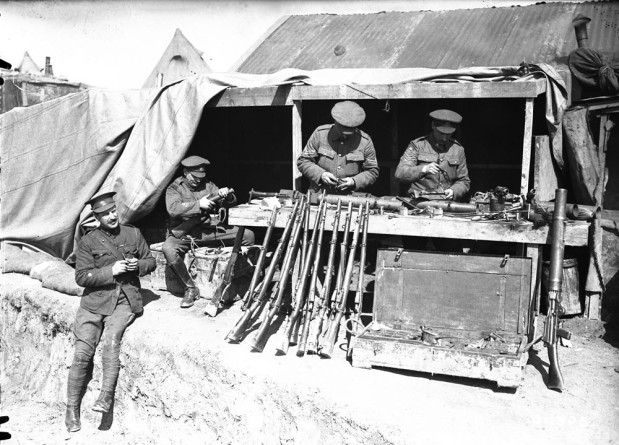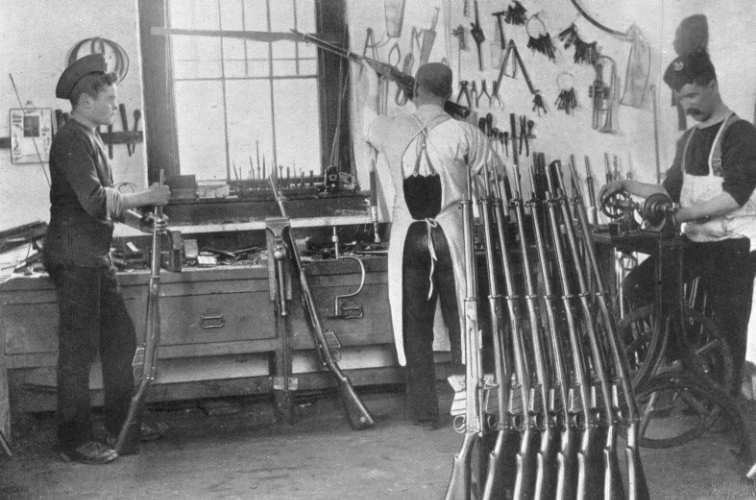Highwood Classic Arms
Lee Enfield Servicing & Repair
SMLE & No4 Lee Enfield
Contact Simon Pemberton on Mobile 07952 119609 or Email: highwoodclassicarms@hotmail.co.uk
Most Accuracy Problems are caused by poor fitting Fore-Ends which can normally be rectified.

We Can Undertake Most Repairs On All Types of Lee Enfield Rifles From Early Lee Metfords to the L42A1
We only use traditional methods & materials
~~~~~~~~~~~~~~~~~~~~~
From General Servicing to a Full Restoration
Stock Repairs & Bedding Problems
Replacement Draws Fitted
Re-barrelling - Orignal Barrels (When Available) We Also use Lothar & Criterion Barrels
Rifles Built to Order
Wood Work Stripped & Traditionally Stained so that All Parts Have an Even Colour Match
Stock & Fore-End bedding: Standard Military Specification or Service
Rifle "B" Centre Bedding
~~~~~~~~~~~~~~~~~~~~~~~~~~~~~~~~~
We have a large array of original British Military Lee Enfield Gauges & Specialist Tools & Many I have designed myself
The Lee Enfield Thread Form prior to the No4 (ie the
SMLE & Long Lee's) are non standard, the No4 is mostly BA threads.
The SMLE can have a mixture of the original threads and parts manufactured
post WW2 using the BA Thread Form.
We have most of the taps & dies that cover all these thread forms
Also for the Parker Hale Eye Piece & Cleaning Rods
~~~~~~~~~~~~~~~~~~~~~~~~~~~~~~~~
Lee Enfield Bedding
Customer just brought in a SMLE he had just purchased wondered why the fore-end was moving about
Lee Enfield Bedding
There are two types of bedding for all the Lee Enfield
Models
Standard Military or Non Standard
The Non Standard is know by various names i.e. Bisley Method, Regulated
etc
Word of Warning: Early barrel bands on Long Lees can be bedded for target
use using Asbestos
The purpose of bedding is to control the vibratory effect
of the barrel when fired and to ensure it is consistent between shots
Ideally the bullets should leave the muzzle when the barrel is at its
neutral position
The No4 Fore-End has 6 main bearing surfaces that need to contact with the barrel & action at the correct pressure when being set up.
I always start with the draws that need to be fitted
correctly which push the for-end up against the butt socket.
If there is to much float in excess of 0.010" accuracy will be
effected.
New Draws being fitted to a SMLE, using Lamp Black to acheive the correct fit.
Lee Enfield No4 - Main Bearing Points
Military Specification

Lee Enfield No4 Bedding Issues at The Muzzle

~~~~~~~~~~~~~~~~~~~~~~~~~~~~~~~~~~~~~~~~~~~
The .303 Bore Size
The Bore Diameter is Gauged When New at .303" Accept & .305" Reject
The 1957 REME Inspection Standards "Application of Gauges & Examination of Small Arms & Machine Guns" - Base Workshops
Armourers Plug Gauge 0.307" Must Not Enter The Muzzle more than a 0.250"
WW2 Standards
Unit Standards the 0.308" Gauge Must Not Enter The Muzzle more than a 0.250", the 0.307" Must not pass through the barrel

This is taken from the WW2 REME Armourers Instructions:
This Is One Of The Several Sets Of Plug Gauges; We Use To Gauge Barrel Wear
~~~~~~~~~~~~~~~~~~~~~~~~~~~~~~~~~~~~~~~~~~
Conversion of No4 Mk1 Fore-Ends to No4 Mk2 Pattern
Just been Stained - Waiting To be Oiled
Depending on the Fore-End we would use Walnut, Beech or Birch Inserts
~~~~~~~~~~~~~~~~~~~~~~~~~~~~~~~~~~~~~~~~~
Lee Enfield Magazines
With the different magazine lips for the 7.62mm round,
part of the magazine well had to be machined.
The 7.62mm Round is shorter, so the magazine lips are postioned closer
to the rear.
This applied to all the 7.62mm Conversions:
L42A1, L39A1, 7.62mm CONV, Enfield Envoy, Enfield Enforcer.
The Parker Hale T4 had this machining on the later conversions, but on the earlier versions utilised the .303 magazine, which was used as a loading platform only.
Most of the No4 7.62mm Conversions by the trade never had this machined clearance, and encounter feed difficulties when using the 7.62m magazine

~~~~~~~~~~~~~~~~~~~~~~~~~~~~~
British Armoury Circa 1890's
Long Lees With Their Pattern 88 Bayonets Stored in Numbered Racks
Its Very Common For British Arms to Have Rack Numbers
Stamped On Them

~~~~~~~~~~~~~~~~~~~~~~~~~~~~~
The Armourers Shop behind the Canadian lines at Vimy Ridge. May, 1917.

Lee Enfield Battlefield Pick Ups

The Armoury of the 149th Bombing Squadron at their aerodrome near St. Omer, 19 July 1918.

~~~~~~~~~~~~~~~~~~~~~~~~~~~~~~~~~~~~~~~~~~~~~~~~~
Armourers Work Bench - Lee Metfords

Armourers Instuctions Schematic - Lee Metford MkII

Armourers Instuctions Schematic - Lee Enfield No7 Mk1

Armourers Schematic - Skeleton Action SMLE

All content of this website © 2022 Highwood Classic Arms as author under the Copyright, Designs and Patents Act 1988